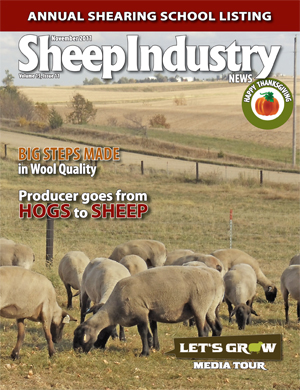
- November 2011
- 2011-2012 Shearing Schools
- Calling Young Sheep Entrepreneurs
- Hog Producer Turned Sheepman in Georgia
- Let’s Grow Media Tour Kicks off in Iowa and Minnesota
- Nov. 18 Deadline for ASI Awards
- Pelt Market Dependent on a Variety of Factors
- State Producers Valuable to University Programs
- U.S. Wool Producers Make Big Steps in Quality Improvement
Becky Talley
Sheep Industry News Associate Editor
(November 1, 2011) American wool producers have taken many steps from improving genetics to improving wool management practices, and their efforts have been noticed and paid off handsomely.
“Quality is what sells, and I believe that growers have become more aware of packaging and wool contamination issues and are doing well,” says Larry Prager, manager of Center of the Nation Wool.
This sentiment has been echoed all through the wool supply chain. At a recent shearer’s tour of Chargeurs Wool USA and Burlington, representatives of both companies commented on how much the quality of wool has improved in this past year’s clip.
Producers are taking extra care to avoid contamination of paint, vegetable matter and polypropylene, are keeping their wool cleaner and giving an overall better presentation, says Diego Paullier, commercial manager at Chargeurs, a top making facility, adding that better quality wool not only brings in better prices for producers, it also influences his business as well. “It improves the efficiencies of machines, improves yields and demands less labor to correct all defects on wool. All these things improve processing costs, so at the same time, increase the value of American wool.”
According to Prager, those that pay attention to wool quality have been and will continue to enjoy the historic prices that have been seen in the wool market.
“You have to have good quality or the market is going to miss you. The growers that were doing a good job with genetics and quality were those in the position this spring to be paid for their efforts, and clearly they were,” he says. “2011 was a record setter in many ways, and I think a lot of the market forces that drove big values in 2011 (such as the high-dollar, fine-wool market) are still going to be in the market. 2012 looks like another opportunity for those with good genetics and quality.”
Paullier suggests that producers continue their progress and focus on further reducing paint contamination, separating black- and kemp-wooled sheep from fine-wool sheep and continuing to work on presentation.
A key to this is participating in education programs offered by ASI.
ASI’s American Wool Council (AWC) reminds producers that participation in the industry’s wool quality programs requires annual self certification. The council continues to encourage all producers to participate in the Certified Wool Clip program in an effort to improve the quality of the U.S. wool clip. For more information on this program see page 28.
“Education is very important, so ASI’s wool quality programs have been very important. Price depends on markets, and we don’t manage markets, but we can all manage or work for quality improvement,” says Paullier.

